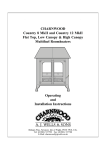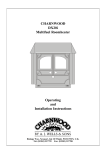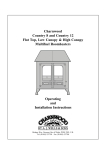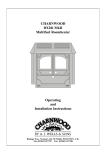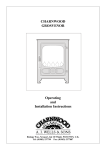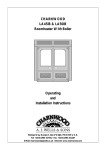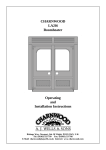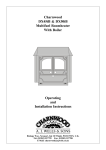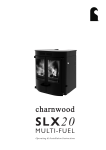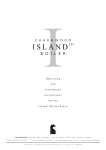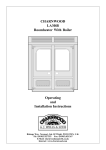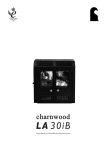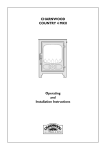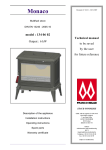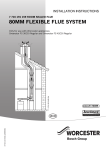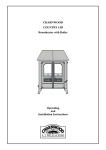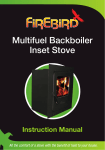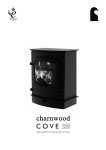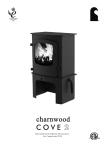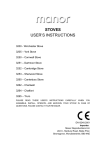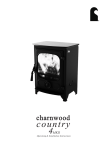Download Charnwood SLX20 Gas Heater User Manual
Transcript
CHARNWOOD SLX20 Multi-Fuel Roomheater Operating and Installation Instructions Bishops Way, Newport, Isle of Wight, PO30 5WS, U.K. Tel: +44(0)1983 537799 Fax: +44(0)1983 537788 E-Mail: [email protected] Internet: www.charnwood.com CHARNWOOD SLX20 Operating and Installation Instructions Contents Operating Instructions General Points. . . . . . . . . . . . . . . . . . . 3 Fuels . . . . . . . . . . . . . . . . . . . . . . . . . . 3 Door Operation . . . . . . . . . . . . . . . . . 4 Multifuel Grate . . . . . . . . . . . . . . . . . . 4 Lighting . . . . . . . . . . . . . . . . . . . . . . . . 3 Controlling The Fire . . . . . . . . . . . . . . 4 Running With The Doors Open. . . . . 4 Ash Clearance . . . . . . . . . . . . . . . . . . . 4 Riddling . . . . . . . . . . . . . . . . . . . . . . . . 5 Refuelling . . . . . . . . . . . . . . . . . . . . . . 5 Overnight Burning. . . . . . . . . . . . . . . . 5 Throat Plate and Flueway Cleaning . . . 5 Special Points When Burning Coal . . . 5 Cleaning and Maintenance. . . . . . . . . . 5 Throat plate & Flueway Cleaning. . . . . 5 Chimney Sweeping . . . . . . . . . . . . . . . 6 Trouble Shooting. . . . . . . . . . . . . . . . . 6 Installation Instructions Health & Safety Precautions . . . . . . . . 8 Performance . . . . . . . . . . . . . . . . . . . . 8 Chimney . . . . . . . . . . . . . . . . . . . . . . . 8 Heath and Fire Surround . . . . . . . . . . 8 Preparation of the Fireplace . . . . . . . . 8 Fitting the Fire . . . . . . . . . . . . . . . . . . . 9 Hot Water System . . . . . . . . . . . . . . . 9 Fitting the Optional Add-In Boiler . . . . 9 Flue Connections & Infilling . . . . . . . . 10 Thermostat . . . . . . . . . . . . . . . . . . . . 10 Pre Lighting Check . . . . . . . . . . . . . . 11 Commissioning . . . . . . . . . . . . . . . . . 11 Overall Dimensions . . . . . . . . . . . . . . 11 Bishops Way, Newport, Isle of Wight, PO30 5WS, U.K. Tel: +44(0)1983 537799 Fax: +44(0)1983 537788 E-Mail: [email protected] Internet: www.charnwood.com OPERATING INSTRUCTIONS FOR THE CHARNWOOD SLX20 GENERAL POINTS PETROLEUM COKE IS NOT SUITABLE FOR USE ON THIS APPLIANCE, ITS USE WILL INVALIDATE THE GUARANTEE Before lighting the fire check with the installer that the work and checks described in the installation instructions have been carried out correctly and that the chimney has been swept, is sound, and free of any obstructions. WARNING There must not be an extractor fan fitted in the same room as this appliance as this can cause the appliance to emit smoke and fumes into the room. If the appliance is fitted in place of an open fire then the chimney should be swept one month after the installation to clear any soot falls which may have occurred due to the difference in combustion between the appliance and the open fire. When using the fire in situations where children or infirm people are present please use a fire guard to prevent accidents. The fire guard should be manufactured in accordance with BS 6539. At first you may find it helpful to try several fuels to find the most suitable. If you are unable to obtain the fuel you want, ask your supplier or an approved fuel distributor to suggest an alternative, or ring the Solid Fuel Association Helpline on Freephone 0800 600 000. FUELS The following smokeless fuels are suitable for use on this appliance: Ancit (Phurnacite Plus), Anthracite Large Nuts, Centurion, Cosycoke, Extracite, Maxibrite, Phurnacite, Welsh Dry Steam Coal (large Nuts) Turn handle clockwise to open Thermostat Control Knob The above fuels are all suitable for use in smoke control areas. In other areas the following fuels may also be burnt: Thermostat flap (behind side panel) COAL Housecoal Doubles, Trebles or cobbles may all be burnt. Do not use singles, small nuts, or coal dust. It is important that the large size coal is used (i.e. Larger than 2” or 50mm in size). Airwash Control pull to open The coal should be dry.When burning bituminous coal a little extra care is needed. Please Take note of the section “Special Points For Burning Coal” Wood Only Dry well seasoned wood should be burnt on this appliance as burning wet unseasoned wood will give rise to heavy tar deposits. For the same reason hard wood is better than soft wood. Burning wet unseasoned wood will also result in considerably reduced outputs. The wood should be cut and split and then left to season in a well ventilated dry place for at least one year preferably two years Before use. PEAT Ensure that the peat is well dried before use. Burning wet peat will give rise to heavy tar deposits and reduce outputs. Fig. 1. Controls Page 3 SLX20 9.03 DOOR OPERATION The doors are opened by raising the door handle as shown in Fig. 1.Whenthefireisalight,avoidtouchingthedoors other than on the knobs as the metal will become hot. When closing the doors do not use excessive force. MULTIFUEL GRATE Your Charnwood is fitted with a multifuel grate which enables solid fuel, wood and peat to be burned equally effectively. The grate has two positions. One for solid fuel, the other for wood and peat.When in the solid fuel position ash can fall through the grate and into the ashpan.When in the wood position ash is able to build up on the grate as is necessary for effective wood or peat burning. Movement of the grate from one position to the other is effected using the tool supplied. The grate is put into the wood position by moving the tool up until the tool is vertical. The grate is put into the solid fuel position by moving the tool down until the tool is horizontal. Do Not Go Beyond 45° Position When Riddling Tool to be Vertical For Wood Or Peat Riddle Between Horizontal & 45° Positions Tool To Be Horizontal For Solid Fuel If a mixture of wood and solid fuel, or peat and solid fuel, is to be burnt then keep the grate in the solid fuel position. LIGHTING Place some paper and dry kindling wood or fire lighters on the grate and cover with a small amount of fuel. Turn the thermostat control knob to maximum setting and light the paper or fire lighters. Close the doors and allow the fire to burn until the fuel is well ignited then load with more fuel and adjust the thermostat to the required level. Fig. 2. Grate Operation RUNNING THE FIREWITHTHE DOORS OPEN On initial lighting, the fire may smoke and give off an odour as the silicon paint with which the firebox is painted reacts to the heat. This is normal and will cease after a short time. In the meantime the room should be well ventilated. The fire may be run with the doors open if desired although this will result in a reduction in efficiency and hence output. The more reactive fuels, like homefire, will burn better when the doors are left open than fuels like phurnacite and ancit. Before relighting the fire, riddle, remove any clinker from the firebed and empty the ashpan. For safety reasons, if the fire is to be left unattended with the doors left open then use a spark guard which complies to BS 3248. CONTROLLING THE FIRE The rate of burning and hence the output is controlled by the control knob on the left hand side of the appliance and the airwash control on the right, shown in fig. 1. Use the control knob on the left to control the heat output from the fire and keep the airwash control slightly open most of the time to keep the glass clean. It will not be possible to keep the glass clean if the ashwash control is fully closed, particularly after refuelling. The number at the top of the control knob is the number at which it is set, the higher the number the faster the burning rate. ASH CLEARANCE The ashpan should be emptied regularly before it comes too full. The most convenient time to remove the ash is just before riddling the fire since the ash will be at it’s coolest. Use the ashpan/riddling tool provided to remove the ashpan, the fold up carrying handle should be held with a heat proof glove. Never allow the ash to accumulate in the ashpan so that it comes in contact with the underside of the grate as this will seriously damage the grate bars. Ensure that the air inlet damper is not prevented from closing by spillage fuel or ash. Care should be taken to ensure that the ash is cool before emptying it into plastic liners or bins. Page 4 SLX20 9.03 THROAT PLATE AND FLUEWAY CLEANING To make ash removal easier there is a special Charnwood ash carrier available. This may be purchased from you supplier or, in case of difficulty, from ourselves. It is important that the throat plate and all the appliance flueways are kept clean. When burning smokeless fuels they should be cleaned at least monthly. When burning other fuels they should be cleaned once a week, and more frequently if found necessary. RIDDLING Riddling twice a day is usually sufficient. The fire should be riddled with the doors shut. Place the tool on the knob and rotate between the horizontal and the 45° position several times as shown in Fig. 2. The throat plate and flue ways may be cleaned with a low fire still burning. Use the scraper tool to scrape any sooty deposits off the front of the plate until they drop into the fire. Caution: when riddling the grate using solid fuel do not go beyond the 45° position as this can cause the grate to jam. More soot will be deposited on the throat plate and in the flueways if the appliance is run at low levels for long periods. If this is the case then more frequent cleaning will be necessary. If jamming does occur then the fire should be allowed to burn for approximately half an hour before riddling the grate again as described above. Too much riddling can result in emptying unburnt fuel into the ashpan and should therefore be avoided Clinker should regularly be removed from the firebed. SPECIAL POINTSWHENBURNING COAL After riddling, the grate should be put back into the solid fuel or wood position as required (the tool should be horizontal for solid fuel or vertical for wood). When burning housecoal keep the airwash control at least sightly open all the time (refer to Fig. 1.) When loading the appliance take care not to smother the fire, instead fill the firebox in two stages waiting for the flames to appear above the fire. REFUELLING Keep the firebox well filled (the fuel may be sloped up from the front fire bars), but not to allow the fuel to spill over the top of the front fire bars. Take care, especially when burning wood, that the fuel does not project over the front fire bars or damage to the glass may be caused when the doors are closed. After a period of slumbering always turn the air control up to maximum and wait until flames appear above the fuel bed before opening the doors. Burning coal will produce more soot deposits than other fuels, especially if the fire is run at low levels for a long periods. It is therefore vital to clean the throat plate regularly, weekly cleaning is recommended. OVERNIGHT BURNING Empty the ashpan, if necessary, and then riddle the fire if you are burning solid fuel. If the fire is very low then it may be necessary to add a little fuel and turn the thermostat control up to maximum for a brief period until the fire is burning brightly before filling with fuel. When burning wood use large logs overnight as they will burn more slowly than small ones. CLEANING AND MAINTENANCE Cleaning The appliance is finished in vitreous enamel. To clean the surfaces simply wipe over with a dry cloth. Abrasive pads and scouring cleaners must not be used as these will damage the finish. Care should be taken not to knock the enamel with hard objects as it will chip. Some experimentation may be necessary to find the setting most suitable for the particular fuel used and the draw on the chimney, but generally the thermostat should be turned down to the minimum setting. Cleaning the Glass The glass in the doors is a special ceramic glass which is able to withstand high temperatures. Before cleaning the glass open the doors and allow them to cool. Clean the glass using a damp cloth and then wiping over with a dry cloth. Any stubborn deposits on the glass may be removed with a proprietary stove glass cleaner or ceramic hob cleaner. Some deposits on the glass may be burnt off simply by running the fire at a fast rate for a few minutes. Do not use abrasive cleaners or pads as these can scratch the surface which will weaken the glass and cause premature failure. Aerosol spray cleaners should not be used near the appliance whilst it is under fire. For overnight burning the fire doors must be closed. To revive the fire, empty the ashpan if necessary, riddle (when burning solid fuel) and turn the thermostat control to maximum. When the fire is burning well load more fuel as necessary and turn the control knob to the desired setting. When burning wood do not riddle but simply set the air controls to maximum until the fire picks up and then set them at the required setting and refuel as necessary. Page 5 SLX20 9.03 b) the thermostat knob is turned down to the minimum setting and the airwash is closed, c) the air inlet damper is closed (at the bottom left of the appliance, see Fig. 1.) and that it is not prevented from closing completely by a piece of ash, d) a suitable fuel is being used, e) the door seals are in good condition. When not in use If the fire is going to be out of use for a long period, (for instance in the summer,) then to prevent condensation, and hence corrosion, the thermostat should be left at the maximum setting and the main doors left ajar. It is also advisable to sweep the chimney and clean out the fire. Spraying the inside of the doors and firebox with a light oil, such as WD40, will also help to keep all internal parts working well. Over-Firing If the fire is over- firing it will cause premature failure of the internal fire parts. Overfiring is occurring when any internal parts of the fire begin to glow red. To prevent over-firing ensure that: a) the door seals are kept in good condition, and that the doors are sealing correctly, b) the thermostat on the fire is working correctly, c) a suitable fuel is being used. Door Seals For the fire to operate correctly it is important that the door seals are in good condition. Check that they do not become worn or frayed and replace them when necessary. Servicing It is recommended that the fire is serviced once a year to keep it in first class working order. After cleaning out the firebox thoroughly, check that all internal parts are in good working order, replacing any parts that are beginning to show signs of wear. Check that the door seals are in good condition and that the doors seal correctly. Check the operation of the thermostat, both when cold and hot. A servicing guide, TIS 48. is available on request. Fume Emission Warning Note: Properly installed and operated this appliance will not emit fumes. Occasional fume from deashing and re-fueling may occur. Persistent fume emission is potentially dangerous and must not be tolerated. If fume emission does persist then take the following immediate actions should be taken: CHIMNEY SWEEPING a) Open the doors and windows to ventilate the room. b) Let the fire out and safely dispose of fuel from the appliance. c) Check for flue or chimney blockage, and clean if required. d) Do not attempt to relight fire until cause of fume has been identified, if necessary seek professional advise. The chimney should be swept at least twice a year. In most installations it will be possible to sweep the chimney through the appliance. First remove the front firebars and the throat plate. Then sweep the chimney ensuring that soot is removed from all horizontal surfaces after sweeping. The most common cause of fume emission is flueway or chimney blockage. For you own safety these must be kept clean. In situations where it is not possible to sweep through the appliance the installer will have provided alternative means, such as a soot door. After sweeping the chimney the appliance flue outlet and the flue pipe connecting the appliance must be cleaned with a flue brush. Freezing If a boiler is fitted do not light the fire if there is any possibility that any parts of the system may be frozen. After cleaning any soot from within the fire, replace the throat plate and the front firebars. Chimney fires If the chimney is thoroughly and regularly swept, chimney fires should not occur. However, if a chimney fire does occur then turn the control knob to the minimum setting (see Fig. 1), and tightly close the doors of the appliance. This should cause the chimney fire to go out in which case the control should be kept at the minimum setting until the fire in the appliance has gone out. The chimney and flueways should then be cleaned. If the chimney fire does not go out when the above action is taken then the fire brigade should be called immediately. Different types of sweep’s brushes are available to suit different flueways. For standard brick chimneys a wire centre sweep’s brush fitted with a guide wheel is recommended. For prefabricated insulated chimneys the manufacturers instructions with regard to sweeping should be consulted. TROUBLE SHOOTING Fire Will Not Burn. After a chimney fire the chimney should be carefully examined for any damage. Expert advise should be sought if necessary. Door Glass Backs Up Differences in chimney draughts mean that the best setting of the air controls will vary for different installations. A certain amount of experimentation may be required, however the following points should be noted and with a little care should enable the glass to be kept clean in most situations: a) The airwash relies on a supply of heated air to keep the Check that: a) the air inlet is not obstructed in any way, b) chimneys and flueways are clear, c) a suitable fuel is being used, d) there is an adequate air supply into the room, e) an extractor fan is not fitted in the same room as the fire. Fire Blazing Out Of Control. Check that: a) the doors are tightly closed, Page 6 SLX20 9.03 It is always more difficult to keep the glass clean when running the stove very slowly for long periods. glass clean, therefore, when lighting the stove allow the firebed to become well established before turning the thermostat down. It may sometimes be beneficial to also keep the doors slightly ajar whilst the fire becomes established. This can also apply when re-fuelling. b) When re-fuelling keep the fuel back a little from the front firebars, do not try to fit too much fuel into the firebox. c) Never completely clse the airwash control - as a guide it should be at least a quarter open. d) Wet wood or logs overhanging the front firebars will cause the glass to blacken. If blackening of the glass still occurs check that all flue connections are well sealed. It is also important that the chimney draw is sufficient and that it is not affected by down-draught.Whenthechimneyis warm a draught reading of at least 2.5mm (0.10 inches) water gauge should be obtained. Page 7 SLX20 9.03 INSTALLATION INSTRUCTIONS FOR THE CHARNWOOD SLX20 HEALTH AND SAFETY PRECAUTIONS checked, it must be in good condition, free from cracks and blockages, and should not have a excessive cross sectional area (e.g. Greater than 250mm x 250mm). If you find that the chimney is in poor condition then expert advice should be sought regarding the necessity of having the chimney lined. If it found necessary to line the chimney then a lining suitable for Solid Fuel must be used. WARNING please take care when installing the appliance that the requirements of the Health and Safety at Work Act are met. Some types of fire cement are caustic and should not be allowed to come into contact with the skin. In case of contact wash with plenty of water. If there is no existing chimney then a prefabricated block chimney or a twin walled insulated stainless steel flue to BS:4543 can be used either internally or externally. These chimneys must be fitted in accordance with the manufacturers instructions and Building Regulations. If there is a possibility of disturbing any asbestos in the course of installation then please use appropriate equipment. Single wall flue pipe is suitable for connecting the appliance to the chimney but is not suitable for using for the complete chimney. There must not be an extractor fan in the same room as the appliance as this can cause the appliance to emit fumes into the room. If it is found there is excessive draw in the chimney then a draught stabiliser should be fitted. There must be an adequate air supply to the room in which the appliance is installed totalling at least 100 square cm. (16 square inches) to provide combustion air. This is particularly necessary if the room is double glazed. HEARTH AND FIRE SURROUND In addition to these instructions the requirements of BS:8303 and BS:6461 Pt 1&2; 1984 must be fulfilled. Local Authority Bye-laws and Building Regulations regarding the installation of Solid Fuel burning appliances, flues and chimney must be observed. The appliance must be installed on a fireproof hearth and must be situated at least 300mm (12 inches) from any combustible material. The positioning of the appliance and the size of the hearth are governed by building regulations for Class 1 appliances. These building regulations state that the hearth must extend in front of the appliance by at least 300mm (12 inches) and to the sides by at least 150mm (6 inches). If in doubt as to the positioning of the appliance expert advise should be sought either from the supplier or the local building inspector. PERFORMANCE The rated output for the SLX20 is 5.4 kW (18500btu/h) to the room. The fireplace must allow good circulation of air around the appliance, especially above it, to ensure that maximum heat is transferred to the room and also to prevent the fireplace overheating. A gap of 150mm (6 inches) each side and 300mm (12 inches) above the appliance should give sufficient air circulation. If a wooden mantelpiece, beam or surround is used in the fireplace it should be a minimum of 460mm (18 inches), and preferably 600mm (24 inches) above the appliance. In some situations it may be necessary to shield the beam or mantelpiece to protect it. This is the output obtained burning smokeless fuel with the doors closed over a 4 hourly re-fueling interval. There is an optional add-in domestic hot water boiler available with an output of 2.0 kW (6800 btu/h). If this is fitted then the output to the room will be reduced by a corresponding amount. CHIMNEY In order for the appliance to perform satisfactorily the chimney height must not be less than 4 metres measured from the outlet of the fire to the top of the chimney. The chimney should preferably be 175mm (7 inches) or 200mm (8 inches) internal diameter or square with sides of 175mm or 200mm internally and MUST NOT BE LESS THAN 150mm (6 INCHES) INTERNAL DIAMETER OR 150 x 150MM INTERNAL SQUARE. PREPARATION OF THE FIREPLACE Before fitting the appliance into an existing fireplace remove the fire back and any loose in-fill material. The surround and opening for the appliance must conform with Figs. 3. The flat area around the opening must be a minimum of 750mm wide and 660mm high. Ensure that the hearth and the base in the opening are flat, level, and at If an existing chimney is to be used it must be swept and Page 8 SLX20 9.03 the open vent. If an indirect cylinder is used then the primary circuit should be filled with a suitable inhibitor to prevent the build up of scale and corrosion. The shaded area on the face of the surround is the minimum flat area required. 750 mm B FITTING THE OPTIONAL ADD-IN BOILER 660 mm A The boiler replaces the rear firebrick and is reversible so that the 1” B.S.P. male tappings may come on either the left or the right hand side of the boiler. Dim. A: Max. 470mm (18 1/2") Min. 405mm (16") Dim. B: Max. 575mm (22 2/3") Min. 555mm (21 3/4") The boiler tappings protrude from the sides of the appliance and it will therefore be necessary to fit the boiler into the appliance after positioning the appliance in the fireplace if the fire surround is already fitted. Fig. 3. Limiting Dimensions Of Surround And Opening Before fitting the boiler, remove the front firebars, the side and back fire plates and the firebricks. Knock out the knockouts for the boiler tappings on the appropriate side of the firebox. right angles to the surround. Make a hole in the font of the chimney breast to give access for infilling and fixing the flue pipe. If the optional boiler is to be fitted it will also be necessary to make a hole in the side of the chimney breast to give access for the pipework. Remove the backnuts and fibre washers from the boiler tappings and fit the boiler into the appliance. Place the fibre washers over the tappings on the outside of the appliance and fit the backnuts, ensuring that the boiler is held tightly against the rear inside face of the appliance and that the top edge of the boiler is level or runs uphill to the flow tapping. FITTING THE FIRE In some cases it may be necessary to place the connecting flue pipe in the chimney before fitting the fire into the fireplace. When re-fitting the firebricks, note that the short side firebrick supplied with the boiler must be fitted on the same side as the boiler tappings. One of the original sidebricks is fitted on the other side, and the rear brick is discarded. The firebricks are held in position by the retaining brackets. Apply fire cement to the rear face of the sealing flange on the appliance. Fit the appliance into the opening ensuring that it is central and that a good seal is made between the sealing flange and the face of the surround. Remove any excess fire cement from around the sealing flange. The appliance should be screwed to the hearth through the holes at the base of the sealing flange. 22mm Open Vents Feed and Expansion Tank Overflow Cold Water Tank Overflow HOT WATER SYSTEM Domestic Hot Water Draw Off The optional add-in boiler which may be fitted in the appliance has an output sufficient for domestic hot water heating. If the boiler is fitted then the room heating will be reduced. Drain Cock Indirect Hot Water Cylinder The hot water system should be a gravity circuit and must be correctly vented as shown in Fig. 4. A double feed indirect hot water storage cylinder to BS:1566 part 1 should be used in most situations, unless the appliance is to be fitted in a soft water area in which case a direct hot water cylinder may be used provided that the boiler is stainless steel. Drain Cock at Lowest Point All pipework in the primary circuit must be 28mm diameter and the flow pipe must rise continuously from the boiler to Fig. 4. Typical Gravity Hot Water System Page 9 SLX20 9.03 Replace the back fireplate, the side fireplates, the front firebar and the throat plate. Flaunching Connect the boiler to the heating system ensuring that the flow pipe rises from the boiler. Fill the system with water and check for leaks. Take Flue Pipe Up To Narrowest Part Of Chimney. FLUE CONNECTION AND INFILLING 150° Elbow Part No. 010/AV12 Make the flue connection with the special 150° elbow, Part No. 010/AV12. Please note that this item is ordered separately from the appliance. The legs of the elbow may be cut on site to suit the chimney. Also note that the legs of the elbow are different lengths to enable some situations to be catered for by turning the elbow around. 150° Vermiculite Infill The end of the flue pipe must line up with the centre-line of the chimney, and must also extend to the point where the chimney narrows to its final size. Any large voids must be filled and flaunched to the flue pipe to ensure that all soot deposits can be cleared when the appliance is swept, and to prevent problems with the operation of the appliance. Ensure that the flue pipe is not obstructed or restricted in any way and that all joints are well sealed. Before infilling cover the front of the appliance to protect it. Ensure that the flue pipe is central and then fill the space between the body of the appliance and the structural brickwork with vermiculite (e.g. Micafil or similar) concrete. Ensure that there are no air pockets. The recommended mix is six volumes of vermiculite to one volume of portland cement throughly mixed together. Enough water should be added so that no more than one or two drops of water are released when a handful ofmixture is squeezed. Fig. 5. Typical Installation After filling with vermiculite flaunch the top of the flue connector pipe to the chimney with lime mortar. Ensure that the flue pipe is well sealed to the chimney. Flap Just Closed With Knob Set To Minimum Make good hole(s) in the chimney breast making sure that it is completely airtight. A typical installation is shown in fig. 5. In most installations it will be possible to sweep the chimney through the appliance. If this is not possible then some alternative means (such as a soot door) must be provided. The free inset method of installation may be used instead of infilling. Details are available on request. THERMOSTAT Before lighting the fire check the cold setting distance of the thermostat. Locking Nut With the control knob at the minimum setting the flap should be just closed as shown in Fig. 6. To adjust the distance slacken the locking nut and adjust as necessary. When set correctly re-tighten the locking nut. Ensure that the flap opens and closes freely as the knob is turned. Thermostat Flap Fig. 6. Thermostat Setting Page 10 SLX20 9.03 ASSEMBLY Fit the side panels and the hood onto the appliance. Instructions for this are enclosed with the panel pack. Replace any internal parts previously removed. PRE LIGHTING CHECK Before initial lighting check the following points: 1. The bottom grate bars must all be fitted and should move freely and easily when the riddling mechanism is operated. 2. The plates round the sides and back of the grate must be in position and sitting correctly. 3. The throat plate must be fitted in the roof of the appliance. COMMISSIONING On completion of the installation and after allowing time for the fire cement and mortar to dry out, the fire should be lit and checked to ensure that the smoke and fumes are taken from the appliance up the chimney and emitted safely. Also check all joints and seals. On completion of the installation and commissioning please leave the operating instructions with the customer and advise on the use of the appliance. Knock outs for optional boiler either side 150° 394 156 i/d 84 547 608 506 405 265 199 260 147 548 170 SLX20 Dimensions (All dimensions are in mm) Page 11 SLX20 9.03











